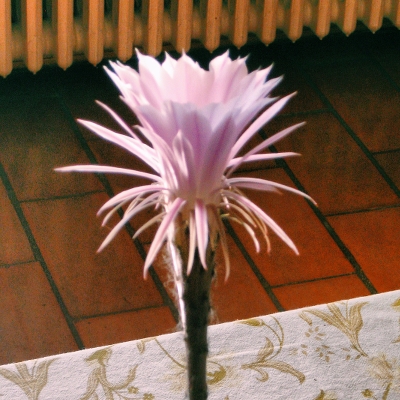 Recently a neighbor in Parma brought over a small, green cactus with a telescopic protuberance; she announced that its cocoon-like blossom would start to open at nine o’clock and die two days later.
Recently a neighbor in Parma brought over a small, green cactus with a telescopic protuberance; she announced that its cocoon-like blossom would start to open at nine o’clock and die two days later.
“The event is a marvel,” she says.
“What’s the name of the cactus?” I ask. She isn’t sure. She only remembers that her mother had called that kind of round cactus “il mondo,” the world.
At nine, the reddish spindle at the tip trembles; by ten, after a strenuous, wet reversal during which the petals seem to sweat, unpeeling, then lifting, my husband and I are fully in the thrall of this luminous, pink flower. (All this while on the TV a new wave of immigrants crawls ashore out of sinking boats from Tripoli—how do we hold these unfoldings in the same moment?)
The work of the three Italian poets Elisa Biagini, Antonella Anedda and Mariangela Gualtieri is not unlike this image, bearing its vital and mysterious contradictions. Each pushes into new worlds, responding, like the cactus flower, to an inner and outer signal. A bloom—sudden, short-lived recognition—opens, transfixing and transforming the witnesses with its solitary purpose. It’s a reminder, as poetry often is, of how myopically we perceive the world’s subtler motions. Meanwhile, other motions continue to tear the world asunder.
While Biagini, Anedda, and Gualtieri have significantly different voices, they are similar in that each poet brings the quotidian to a halt, arranging commonplace objects and language in new light. All three assume the paradoxes of transcription. By putting ordinary words—Salt. Button. Empire. Blood. Truce. Bone. Bones. Spine. Hollow. Lust. Needles. Digging—to unexpected uses, they capture the continuous present. Pots and pans, nightmares, joys, and hypocrisies illuminate history and solitude.
These poets are surrounded by a poetic tradition that has often regarded style and illusion as essential ends. They harness the suggestiveness and sensuousness of the Italian language in simultaneously familiar and original ways. But their styles never obstruct what is ambiguous, harsh, or alien. They embrace the necessary strangeness that gives poetry its transcendent force.
Inside the mondo flower, a golden pistil grows below the circle of stamens. It registers the silence of the universe, and waits. Consider the following: a week ago, at a reading, an Italian poet listed only men as important Italian poets. When he was pressed to reconsider, he retorted, “Yes, there are Italian women poets, some are quite good, but they have never really had a chance to become part of the tradition.”
Elisa Biagini, Antonella Anedda, and Mariangela Gualtieri long ago evaded their country’s traditional poetic poses: intellectual pessimism, irony and hermeticism. Drawing on literary and social resources beyond the canon, their voices can be heard outside of Italy, as well as within.
Elisa Biagini studied in the US after graduating from the University of Florence, and is perhaps the most comfortable (of the three) with personal anecdote. Sometimes writing in dialects that recall her native Sardegna, Antonella Anedda brings an outsider’s perspective to each new volume through an elemental, pre-scholastic language that guides her more literary Italian.Mariangela Gualtieri hears poetry as a living voice and shapes it in rhythms and pitches approaching near mystical incantation. War, fire and disturbance, the colors of silk, sand and milk animate these poets’ ontological questions. They veer toward redemption in life and literature.
So, in response to those who would exclude women from the Italian poetic tradition: Biagini, Anedda and Gualtieri certainly do tap the veins of Greek and Roman traditions, dialect and song, other Italian poets, and poets writing outside the historical and literary canon. These samples represent less than an ink drop of what each has produced. For the moment, let them speak their views as Italian poets. Then let their poetry speak.
Antonella Anedda: Poetry perhaps is “an attempt to go forward and instead it often becomes a return to the beginning.” It is a “turning around, a fire that lights, burns and then goes out.” Anedda observes that reality does not endure. “It needs our protection.” Language can sometimes bring back worlds by digging a “hospitable” hole.
Mariangela Gualtieri: “Poetry wants to be spoken . . . It wants to shake off the dust of the written page. (It is the) foam in mouths that relish the earth of its origins, that have eaten bread, drunk wine.” Poetry is “vital, healing.” It touches the deepest ‘knowing’ parts of the body. Gualtieri often writes poetry to be performed, where she proposes, “especially words to make us human.”
Elisa Biagini: “Poetry is an attempt at living.” Its subjects are often “imploded material to be explored.” What becomes a poem then are often words to be left “in spaces dug out like slits.” Biagini has chosen “the body as the lens through which to read the world.” Articulating readings that the body allows serves “to shed light within ourselves.” She often addresses spaces between the you, the victim of imposed identity, and the role imposed by the self. She is willing to tell stories that are “frightening” but “necessary,” stories about “the self, the other, the body.”









